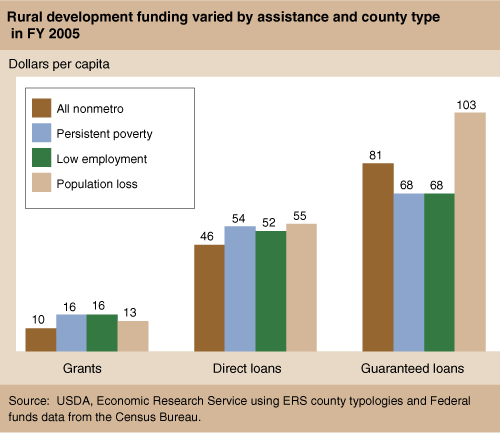The Form of Rural Development Assistance Matters to Distressed Counties
- by Richard Reeder and Faqir Bagi
- 6/1/2010
USDA offers a range of financial assistance programs to rural communities for housing, public utilities, community facilities, and business development. The three most common forms of rural development assistance are grants, direct Government loans, and Government guarantees for private sector loans. Grants and direct loans are costly to the Federal Government, but they can reduce the cost and uncertainty of funding community projects from the rural government’s perspective. In addition, grants can be used to fund activities that cannot easily be funded with loans, such as feasibility studies needed before a project can start. Guaranteed loans, however, are the least costly to the Federal Government because private sector institutions make the loans—paying a fee for the privilege—and the Federal Government reimburses the lenders only if the loans are not repaid.
Distressed rural communities—arguably those most in need of Federal assistance—do not benefit equally from the three forms of assistance. Using the Bureau of the Census’s Consolidated Federal Funds Reports data for 2005, ERS researchers computed per capita USDA rural development funding to all nonmetropolitan counties and to three categories of distressed counties:
- Persistent-poverty counties—high poverty rates in the1970-2000 censuses
- Low-employment counties—low percentage of working-age residents employed in 2000
- Population-loss counties—declining population in the 1980s and 1990s
With grants and direct loans, all three types of distressed areas received more funding per capita than nonmetro areas in general. However, with guaranteed loans, the persistent-poverty and low-employment counties received below-average funding, while the population-loss counties generally received above-average funding, although this pattern differed from program to program.
Given budget pressures, adjustments in the way USDA delivers its rural community assistance are often considered in order to get “more bang for the buck.” This research suggests that there are tradeoffs involved when switching from grants and direct government loans to less costly government guarantees of private sector loans. Program administrators have direct control over grant and direct loan decisions, subject to enabling legislation, so they can target poor or distressed communities with assistance. Guaranteed loans, however, require the active participation of private lenders who may not share the same goals. As a result, guaranteed loans are less amenable to targeting efforts.
This article is drawn from:
- Federal Funds. (n.d.). U.S. Department of Agriculture, Economic Research Service.
- Reeder, R. & Bagi, F. (2010). Geographic Targeting Issues in the Delivery of Rural Development Assistance. U.S. Department of Agriculture, Economic Research Service. EIB-65.


